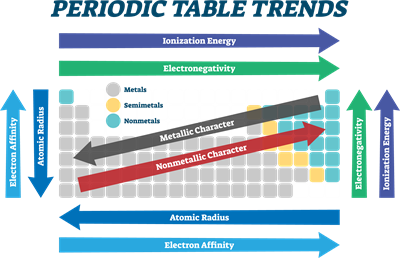PDF chapter test TRY NOW
Atomic size:
Atomic size is defined as the radius of an atom. The distance between the nucleus's centre and the outermost shell of an isolated atom can be shown as the atomic size.
The radius of a hydrogen atom is \(37\) pm (picometre, \(1\) pm = \(10^-{^1}{^2}m\).

Let us analyse the variation of atomic size in a group and a period.
Activity 5.7
1. The atomic radii of the second period elements are given below:
Period II elements | B | Be | O | N | Li | C |
Atomic radius (pm) | 88 | 111 | 66 | 74 | 152 | 77 |
Arrange them in decreasing atomic radii order.
Elements are organised in decreasing order of atomic radius in the table below:
Order | Period II elements | Atomic radius (pm) |
1. | Li | 152 |
2. | Be | 111 |
3. | B | 88 |
4. | C | 77 |
5. | N | 74 |
6. | O | 66 |
2. Are the elements now arranged in the periodic table in the pattern of a period?
Yes, the elements are now arranged in a periodic table pattern.
3. Which elements contain the largest and smallest atoms?
Lithium is the largest atom, and oxygen is the smallest atom.
4. How does the atomic radius change as the period progresses from left to right?
As you move from left to right in a period, the atomic radius decreases.
You will notice that the atomic radius decreases in moving from left to right along a period. This is due to an increase in nuclear charge, which pulls the electrons closer to the nucleus and reduces the atom's size.
Activity 5.8
1. Examine the atomic radii of the first group elements listed below and arrange them in increasing order.
Group 1 Elements | Na | Li | Rb | Cs | K |
Atomic Radius (pm) | 186 | 152 | 244 | 262 | 231 |
In the below table, elements are arranged in increasing order of their atomic radii:
Order | Group 1 Elements | Atomic Radius (pm) |
1. | Li | 152 |
2. | Na | 186 |
3. | K | 231 |
4. | Rb | 244 |
5. | Cs | 262 |
2. Name the elements with the smallest and largest atoms.
The largest atom is Caesium (Cs), and the smallest atom is Lithium (Li).
3. How does the atomic size change as you move down the group?
Atomic size increases as it moves down the group.
The atomic size decreases as you move down the group. This is due to the addition of new shells as we go down the group. This increases the distance between the nucleus's outermost electrons, causing the atomic size to increase despite the increase in nuclear charge.
